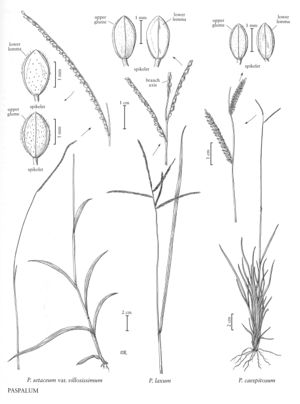Difference between revisions of "Paspalum laxum"
FNA>Volume Importer |
FNA>Volume Importer |
||
| Line 38: | Line 38: | ||
|publication year= | |publication year= | ||
|special status= | |special status= | ||
| − | |source xml=https://jpend@bitbucket.org/aafc-mbb/fna-data-curation.git/src/ | + | |source xml=https://jpend@bitbucket.org/aafc-mbb/fna-data-curation.git/src/f6b125a955440c0872999024f038d74684f65921/coarse_grained_fna_xml/V25/V25_1484.xml |
|subfamily=Poaceae subfam. Panicoideae | |subfamily=Poaceae subfam. Panicoideae | ||
|tribe=Poaceae tribe Paniceae | |tribe=Poaceae tribe Paniceae | ||
Revision as of 19:23, 24 September 2019
Plants perennial; cespitose to short rhizomatous. Culms 80-110 cm, erect; nodes glabrous. Sheaths glabrous, sparsely pubescent apically; ligules 1-2.9 mm; blades 9-41 cm long, 3-7 mm wide, mostly involute, pubescent above, glabrous below. Panicles terminal, with 1-5(10) racemosely arranged branches; branches 1.9-11.4 cm, erect to divergent, terminating in a spikelet; branch axes 0.4-0.7 mm wide, very narrowly winged, scabrous. Spikelets 1.6-2.2 mm long, 1.1-1.3 mm wide, paired, imbricate, appressed to the branch axes, elliptic-obovate to ovate. Lower glumes absent; upper glumes shortly pubescent, 5-veined, margins entire; lower lemmas glabrous or shortly pubescent, lacking ribs over the veins, 3-veined, margins entire; upper florets 1.4-2 mm, white to stramineous. 2n = 60.
Distribution
Puerto Rico, Virgin Islands, Fla.
Discussion
Paspalum laxum grows in hammocks and along roads, often in sandy or limestone soils. It used to be common in coconut groves, hence the English-language name. It grows in southern Florida, the Antilles, and Belize.
Selected References
None.
